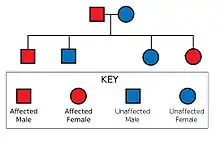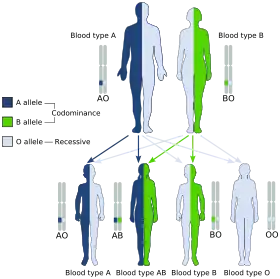Mendelian traits in humans
Mendelian traits in humans concerns how, in Mendelian inheritance, a child receiving a dominant allele from either parent will have the dominant form of the phenotypic trait or characteristic. Only those that received the recessive allele from both parents, known as zygosity, will have the recessive phenotype. Those that receive a dominant allele from one parent and a recessive allele from the other parent will have the dominant form of the trait. Purely Mendelian traits are a tiny minority of all traits, since most phenotypic traits exhibit incomplete dominance, codominance, and contributions from many genes.





The recessive phenotype may theoretically skip any number of generations, lying dormant in heterozygous "carrier" individuals until they have children with someone who also has the recessive allele and both pass it on to their child.
Examples
These traits include:
- Albinism (recessive)[2]:53
- Achondroplasia[2]:53
- Alkaptonuria[2]:53, 263
- Ataxia telangiectasia[2]:53
- Brachydactyly (shortness of fingers and toes)[2]:53
- Colour blindness[2]:53 (monochromatism, dichromatism, anomalous trichromatism, tritanopia, deuteranopia, protanopia)
- Cystic fibrosis[2]:53
- Duchenne muscular dystrophy[2]:53
- Ectrodactyly [3]
- Ehlers–Danlos syndrome[2]:53
- Fabry disease
- Galactosemia[2]:53
- Gaucher's disease
- Haemophilia[2]:53
- Hereditary breast–ovarian cancer syndrome
- Hereditary nonpolyposis colorectal cancer
- HFE hereditary haemochromatosis
- Huntington's disease[2]:53
- Hypercholesterolemia[2]:53
- Krabbe disease
- Lactase persistence (dominant) [4]
- Leber's hereditary optic neuropathy
- Lesch–Nyhan syndrome[2]:53
- Marfan syndrome[2]:53
- Niemann–Pick disease
- Phenylketonuria[2]:53
- Porphyria[2]:53
- Retinoblastoma
- Sickle-cell disease[2]:53
- Sanfilippo syndrome
- Tay–Sachs disease[2]:53
- Wet (dominant) or dry (recessive) earwax – dry is found mostly in Asians and Native Americans[5]
References
- "Inheritance of Sickle Cell Anaemia – Sickle Cell Society". Archived from the original on 2018-03-27. Retrieved 2015-12-29.
- Klug, William S.; Cummings, Michael R.; Spencer, Charlotte A.; Palladino, Michael A. (2012). Essentials of Genetics. Pearson. ISBN 978-0-321-80311-5.
- Sowińska-Seidler, Anna; Socha, Magdalena; Jamsheer, Aleksander (October 2013). "Split-hand/foot malformation - molecular cause and implications in genetic counseling". Journal of Applied Genetics. 55: 105–115.
- Hollfelder, Nina; Bibiker, Hiba; Granehäll, Lena; Schlebusch, Carina; Jakobsson, Matthias (April 2020). "The genetic variation of lactase persistence alleles in northeast Africa". bioRxiv 10.1101/2020.04.23.057356.
- "Myths of Human Genetics: Earwax".
Further reading
- Mange, Elaine J.; Mange, Arthur R. (1999). Basic Human Genetics (second ed.). Sunderland (MA): Sinauer. ISBN 978-0-87893-497-3. Lay summary (16 October 2010).
- Speicher, Michael R.; Antonarakis, Stylianos E.; Motulsky, Arno G., eds. (2010). Vogel and Motulsky's Human Genetics: Problems and Approaches. Heidelberg: Springer Scientific. doi:10.1007/978-3-540-37654-5. ISBN 978-3-540-37653-8. S2CID 89318627. Lay summary (4 September 2010).